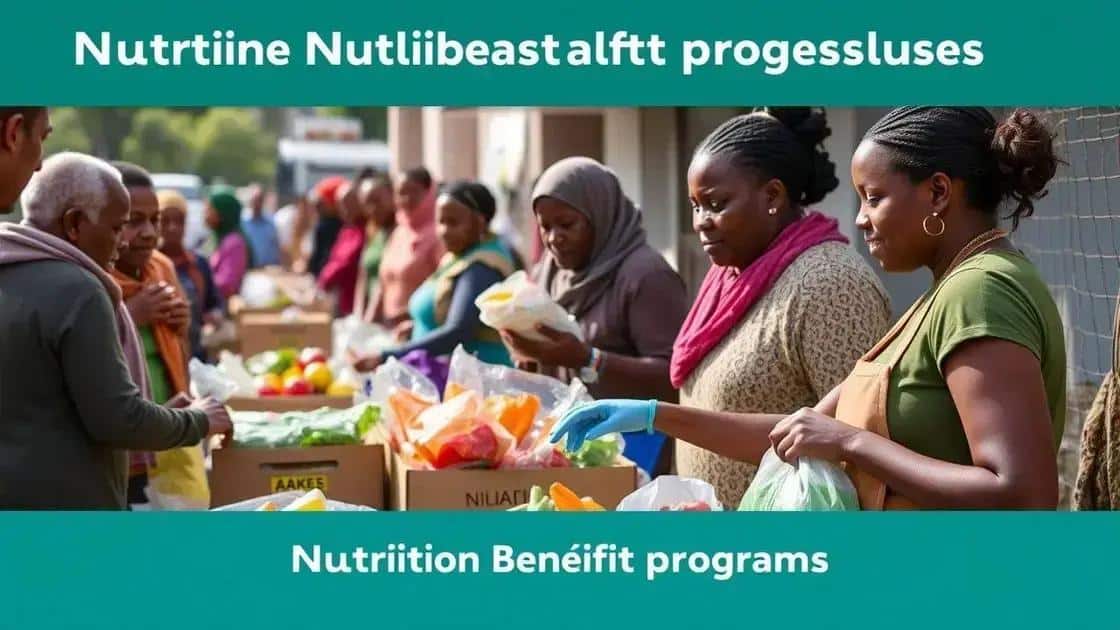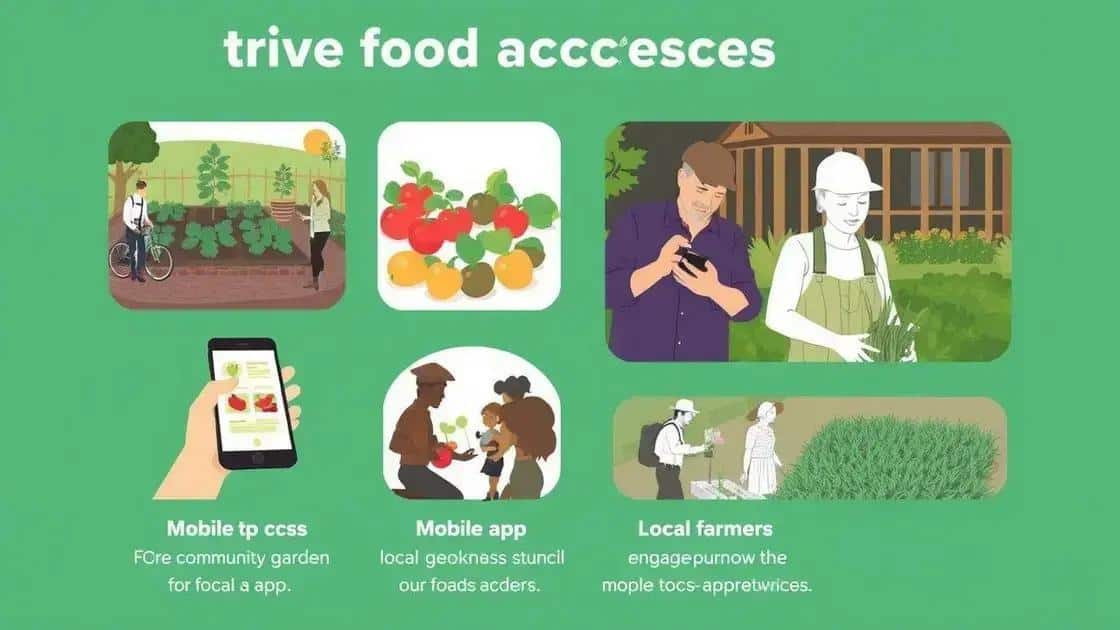Nutrition benefit programs trends shaping the future

Community engagement in nutrition initiatives enhances program effectiveness by involving local residents, fostering trust, and tailoring solutions to meet specific community needs, ultimately promoting better access to healthy food.
Nutrition benefit programs trends are shifting as organizations seek to improve food access for all. Have you noticed how these programs adapt to community needs? Let’s explore the latest developments in this vital area.
Current landscape of nutrition benefit programs
The current landscape of nutrition benefit programs is rapidly changing. With an increase in awareness around food security, programs are adapting to help communities gain access to healthy meals. These initiatives are essential to improve the well-being of individuals and families.
Key Features of Modern Nutrition Programs
Modern nutrition benefit programs focus on accessibility and inclusion. They strive to provide resources that cater to diverse communities. By integrating various forms of assistance, they aim to meet the different needs of the population.
- Flexible eligibility requirements
- Incorporation of local food sources
- Partnerships with community organizations
- Focus on nutrition education
Many programs are shifting towards technology to streamline processes. For instance, mobile apps are helping beneficiaries track their usage of benefits efficiently. This trend not only makes the service more user-friendly but also enhances engagement.
Community-Centered Approaches
A strong focus on community input has emerged within these programs. Engaging local residents ensures that the initiatives are tailored to meet their specific needs. Community feedback plays a crucial role in shaping the types of services offered.
Nutrition programs are increasingly offering cooked meal delivery services along with grocery vouchers. This dual approach addresses immediate hunger while promoting long-term food access. As more families rely on these benefits, strategies continue to evolve, ensuring they remain relevant and effective.
Innovations in food access strategies

Innovations in food access strategies are transforming the way nutrition benefits reach communities. As people become more aware of food insecurity, creative solutions are emerging to enhance accessibility to healthy options.
New Technologies in Food Distribution
Technological advancements are playing a key role in these innovations. Many organizations are using apps to connect food donors with those in need, making it easier for individuals to find available resources. This trend promotes efficiency and reduces waste in the food system.
- Mobile apps for locating food resources
- Online platforms for meal ordering
- Data analytics for better resource allocation
- Enhanced tracking for food donations
In addition to technology, partnerships with local farmers have also gained traction. By collaborating directly with producers, programs ensure fresher food options and support local economies.
Community Engagement and Feedback
Community involvement is crucial for these strategies to succeed. Listening to community needs leads to tailored programs that resonate with residents. Engaging users helps organizations to adapt and improve their services continuously.
Another exciting trend is the emergence of community gardens and urban farms. These initiatives not only provide fresh produce but also foster community spirit and educate residents about nutrition. They help make sustainable food practices a part of everyday life.
Impact of technology on nutrition distribution
The impact of technology on nutrition distribution has been profound, reshaping how communities access food. Digital tools are becoming essential in bridging the gap between food supply and those in need.
Streamlining Food Access
One significant advancement is the use of mobile applications that help individuals locate food sources quickly. These apps provide real-time information about available resources, whether it’s food pantries or community kitchens. This immediate access empowers users to make informed decisions about their nutrition.
- Instant notifications for food availability
- User-friendly interfaces for easy navigation
- Connecting volunteers for food delivery
- Support for dietary needs and preferences
Furthermore, data analytics is enhancing the efficiency of food distribution systems. Organizations can predict demand and allocate resources accordingly, ensuring that food reaches those who need it most.
Enhanced Communication and Engagement
Technology also fosters better communication between food providers and recipients. Social media platforms are utilized to share information, gather feedback, and promote nutrition education. Engaging the community through these channels helps raise awareness about available services.
Moreover, platforms enabling online orders allow clients to select healthy meal options tailored to their needs. This personalization not only improves satisfaction but also encourages healthier eating habits.
Community engagement in nutrition initiatives

Community engagement in nutrition initiatives plays a critical role in ensuring their success. When communities are actively involved, programs can better address local needs and preferences.
Building Relationships
A strong relationship between nutrition programs and community members enhances trust and participation. Community meetings and workshops create spaces for individuals to voice their concerns and share their ideas. This two-way communication fosters a sense of ownership, making residents feel invested in the outcomes.
- Organizing local workshops for nutrition education
- Creating feedback channels for program improvement
- Engaging local leaders to promote initiatives
- Utilizing social media for outreach and participation
When people feel heard, they are more likely to join initiatives, ensuring a wider reach and greater impact.
Collaborative Projects
Collaboration is key in these efforts. Programs often partner with schools, local businesses, and health organizations to broaden their reach. These collaborations can lead to innovative solutions that benefit everyone involved.
For instance, incorporating cooking classes within schools can educate children on healthy eating habits. Similarly, local businesses might support nutrition programs by donating food or providing venues for events. Such partnerships can strengthen community ties while promoting health and wellness.
In conclusion, community engagement in nutrition initiatives is essential for success. By involving local residents, programs become more effective and relevant. Collaboration with schools, businesses, and health organizations enhances outreach and supports healthier choices. Utilizing technology can make food access easier, while open communication builds trust within the community. Together, these strategies create a stronger foundation for improving nutrition and health in our neighborhoods.
FAQ – Frequently Asked Questions about Community Engagement in Nutrition Initiatives
Why is community engagement important in nutrition programs?
Community engagement ensures programs meet local needs and encourages higher participation rates, leading to more successful outcomes.
How can technology improve food access?
Technology, such as mobile apps, can provide real-time information about food resources, making access easier and more efficient.
What role do local partnerships play in nutrition initiatives?
Local partnerships enhance outreach and support, allowing programs to utilize community resources and expertise for better impact.
How can community feedback improve nutrition initiatives?
Community feedback helps tailor programs to better fit the preferences and needs of residents, ensuring relevance and effectiveness.





